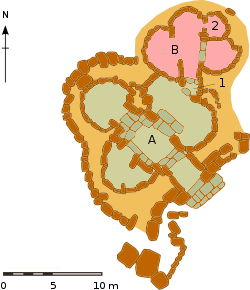Ta' Ħaġrat Temples
 Ta' Ħaġrat | |
| Location | Mġarr, Malta |
|---|---|
| Coordinates | 35°55′07″N 14°22′07″E / 35.9185°N 14.3686°ECoordinates: 35°55′07″N 14°22′07″E / 35.9185°N 14.3686°E |
| Type | Temple |
| Part of | Megalithic Temples of Malta |
| History | |
| Material | Limestone |
| Founded | c.3600 BC–c.3200 BC |
| Periods |
Ġgantija phase Saflieni phase |
| Site notes | |
| Excavation dates | 1923–1961 |
| Archaeologists |
Themistocles Zammit John Davies Evans David Trump |
| Condition | Ruins |
| Ownership | Government of Malta |
| Management | Heritage Malta |
| Public access | Yes |
| Website | Heritage Malta |
| Official name | Megalithic Temples of Malta: Ġgantija, Ħaġar Qim, Mnajdra, Ta' Ħaġrat, Skorba, Tarxien |
| Type | Cultural |
| Criteria | iv |
| Designated | 1980 (4th session) |
| Reference no. | 132 |
| Region | Europe and North America |
| Extended | 1992 |
The Ta' Ħaġrat ([taˈħad͡ʒrat]) temples in Mġarr, Malta is recognized as a UNESCO World Heritage Site, along with several other Megalithic temples.[1] They are amongst the most ancient religious sites on Earth.[2] The larger Ta' Ħaġrat temple dates from the Ġgantija phase (3600–3200 BCE);[3] the smaller is dated to the Saflieni phase (3300–3000 BCE).[3]
Location
Ta' Ħaġrat is on the eastern outskirts of the village of Mġarr, roughly one kilometer from the Ta' Skorba temples.[4] Characteristics of the Ta' Ħaġrat façade resemble those in the Ta' Skorba complex.[3]
Temple Complex
The excavation of plentiful pottery deposits show that a village stood on the site and predates the temples themselves. This early pottery is dated to the Mġarr phase (3800-3600 BCE).[5]
Ta' Ħaġrat is built out of lower coralline limestone, the oldest exposed rock in the Maltese Islands.[6] The complex contains two adjacent temples.[3] The smaller temple abuts the major one on the northern side.
The two parts are less regularly planned and smaller in size than many of the other neolithic temples in Malta.[7] Unlike other megalithic temples in Malta no decorated blocks were discovered; however a number of artifacts were found. Perhaps most intriguing is a scale model of a temple,[8] sculpted in globigerina limestone.

The model is roofed and shows the typical structure of a Maltese temple including a trilithon façade, narrow-broad walling technique and upper layers of horizontal corbelling.[9]
Major Temple
The Ġgantija phase temple is typically trefoil, with a concave façade opening onto a spacious semicircular forecourt. The façade contains a monumental doorway in the center and a bench at its base.[4] Two steps lead up to the main entrance and a corridor flanked by upright megaliths of coralline limestone.[3]

The corridor leads into a central torba (a cement-like material) court, radiating three semi-circular chambers. These were partially walled off at some time in the Saflieni phase;[10] pottery shards were recovered from the internal packing of this wall.[11] The apses are constructed with roughly-hewn stone walls and have a rock floor. Corbelling visible on the walls of the apses suggest that the temple was roofed.[3]
A small sculptured temple was discovered here.[8]
Minor Temple
The Saflieni phase temple rests to the north and is six and a half meters long. It is entered through the eastern apse of the larger temple. Smaller stones have been used in its construction[7] and it exhibits irregularities in design considered archaic or provincial.[12]
Excavation
The site was excavated between 1923 and 1926 by Sir Temi Zammit, then Director of Museums. The site was again excavated by John Davies Evans in 1954, and British archaeologist David Trump accurately dated the complex in the 1961 excavation.[3]
The temple was included on the Antiquities List of 1925.[13]
Restoration
Parts of the façade and doorway were reconstructed in 1937.[14]
See also
References
- ↑ "Megalithic Temples of Malta - UNESCO World Heritage Centre". Whc.unesco.org. Retrieved 2010-09-12.
- ↑ "Malta Temples and The OTS Foundation". Otsf.org. Retrieved 2010-09-12.
- 1 2 3 4 5 6 7 http://www.heritagemalta.org/tahagrat.html
- 1 2 Trump, Cilia. "Malta Prehistory and Temples": 154
- ↑ Trump, Cilia. "Malta Prehistory and Temples": 155
- ↑ "Geology". Semide-mt.org. Retrieved 2010-09-12.
- 1 2 Żammit, Mayrhofer. "The Prehistoric Temples of Malta and Gozo": 142
- 1 2 "Ta Hagrat - Mgarr - Temple Model". Megalithics.com. Retrieved 2010-09-12.
- ↑ Zammit T., "Ta Hagrat Megalithic Ruins at Mgarr, Malta" Bulletin of the Museum, Malta, I, i, 5, 1929.
- ↑ Trump. "Malta: An Archaeological Guide": 139
- ↑ Żammit, Mayrhofer. "The Prehistoric Temples of Malta and Gozo": 143
- ↑ Trump. "Malta: An Archaeological Guide": 140
- ↑ "Protection of Antiquities Regulations 21st November, 1932 Government Notice 402 of 1932, as Amended by Government Notices 127 of 1935 and 338 of 1939.". Malta Environment and Planning Authority. Archived from the original on 20 April 2016.
- ↑ The Megalithic Portal and Megalith Map. "Ta' Hagrat Ancient Temple : The Megalithic Portal and Megalith Map:". Megalithic.co.uk. Retrieved 2010-09-12.
External links
| Wikimedia Commons has media related to Ta' Ħaġrat. |